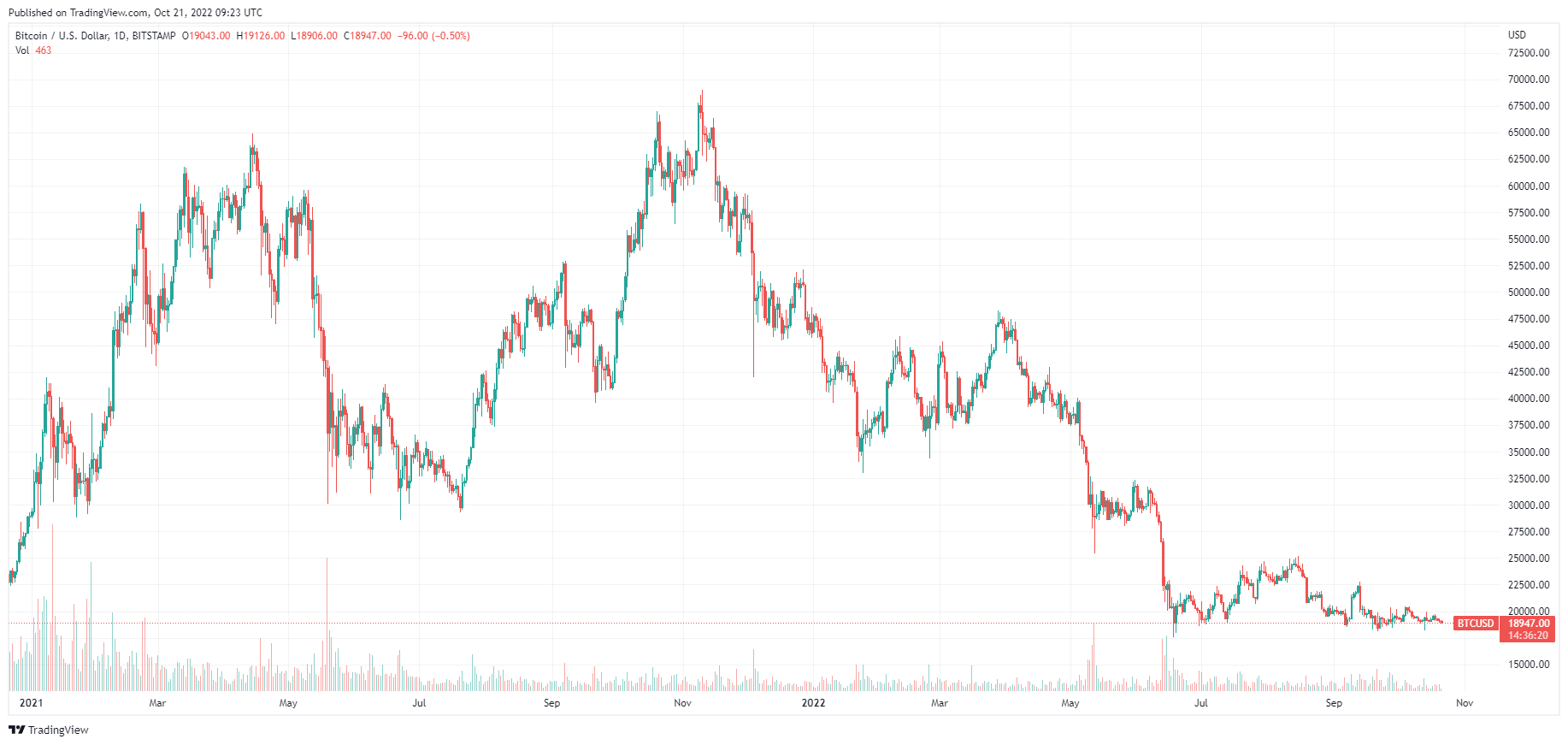Good Morning!
Bitcoin (BTC) and Ethereum (ETH) traded in a tight range this week, finishing basically where they started. Volumes have decreased significantly compared to previous weeks, suggesting that any sudden significant flow could cause volatility. This week’s volume in the biggest BTC market, BTC/USDT on Binance, is currently half as much as last week. The last time we saw less volume was in the week of June 27th.

Aptos: yet another Layer 1
As there were not many developments in the market this week, I would like to take a look at the much-anticipated Aptos launch. There are some sceptical voices, too. Many people, myself included, quickly identified several red flags as events progressed. In short, Aptos is a Layer 1 blockchain built with the Move smart contract programming language, which was developed at Meta to power the permissioned Diem blockchain. Aptos Labs was founded by two Diem core team members.
Similar to Solana, they have implemented a parallel processing engine, opposed to sequential processing used on Ethereum. This allows for multiple transactions to be executed simultaneously. Through this, they plan on being able to process 160,000 transactions per second. Like many other Layer 1s, Aptos is attempting to solve the scalability issue Ethereum faces.
The first red flag is the vast amount of VC funding that was raised. According to Crunchbase, Aptos raised a whopping $350m over three rounds, pre-ICO listing. As a comparison, Solana raised $20m before listing, per Messari. Aptos investors include a16z, FTX Ventures, Jump Crypto, Multicoin Capital, and Binance Labs, to name a few.
APT tokenomics
The second red flag is in regards to the launch of the APT token and its tokenomics, which for me is among the most important metrics when investing in a project. The mainnet was launched on October 12th, and before the token was even live, there were roughly 820m (out of 1bn) tokens staked. Without the tokenomics released yet, I assumed that this meant more than 80% of tokens were held by insiders (team and investors), as they are the only ones who would have had access to a token not listed yet. FTX released a section on tokenomics in their Aptos article, which unfortunately gave no information on the supply of the token, but rather spoke about the use case of the token.
Additionally, the tokenomics were finally released on October 17th, after many prominent crypto Twitter figures publicly ridiculed a listing announcement without the release of token supply and emission. My assumptions were right, 100% of the initial token distribution is held by Community, Core Contributors, Foundation and Investors, but is initially staked. Note that token holders can vote on-chain about changes to the software.
The 51.02% held by Community is not locked, and is set to be distributed over the next 10 years through grants, incentives, and community growth. The remaining 48.98% of APT held by Core Contributors, Foundation, and Investors is subject to a four-year lock-up schedule, excluding staking rewards. The first unlock will start 12 months after the mainnet launch, in November 2023, and will follow a linear release schedule.
Airdrop for early users
The coin was listed on October 18th. Shortly before the listing, the foundation announced (through Twitter) that it would provide early network participants with APT tokens. Just more than 20m APT, or 2% of the initial supply, was airdropped to around 110k participants who completed an Aptos Incentivised testnet or minted a testnet NFT. Most importantly, and most disappointingly, Aptos sent emails to eligible users! This essentially means that emails are tied to individual wallet addresses, defeating the purpose of addresses being used for anonymity.
I’m wondering if a $7bn fully diluted valuation is justifiable when the ecosystem is currently close to non-existent, and the chain is not performing close to its maximum capacity (currently 10.58 TPS). Having said that, though, I look forward to following the developments of the ecosystem, and to being proven wrong if I misunderstood or missed any pertinent information.
Happy Trading!
All intellectual property, proprietary and other rights and interests in this publication and the subject matter hereof are owned by Crypto Broker AG including, without limitation, all registered design, copyright, trademark and service mark rights.
Disclaimer
This publication provided by Crypto Broker AG, a corporate entity registered under Swiss law, is published for information purposes only. This publication shall not constitute any investment advice respectively does not constitute an offer, solicitation or recommendation to acquire or dispose of any investment or to engage in any other transaction. This publication is not intended for solicitation purposes but only for use as general information. All descriptions, examples and calculations contained in this publication are for illustrative purposes only. While reasonable care has been taken in the preparation of this publication to provide details that are accurate and not misleading at the time of publication, Crypto Broker AG (a) does not make any representations or warranties regarding the information contained herein, whether express or implied, including without limitation any implied warranty of merchantability or fitness for a particular purpose or any warranty with respect to the accuracy, correctness, quality, completeness or timeliness of such information, and (b) shall not be responsible or liable for any third party’s use of any information contained herein under any circumstances, including, without limitation, in connection with actual trading or otherwise or for any errors or omissions contained in this publication.
Risk disclosure
Investments in virtual currencies are high-risk investments with the risk of total loss of the investment and you should not invest in virtual currencies unless you understand and can bear the risks involved with such investments. No information provided in this publication shall constitute investment advice. Crypto Broker AG excludes its liability for any losses arising from the use of, or reliance on, information provided in this publication.







